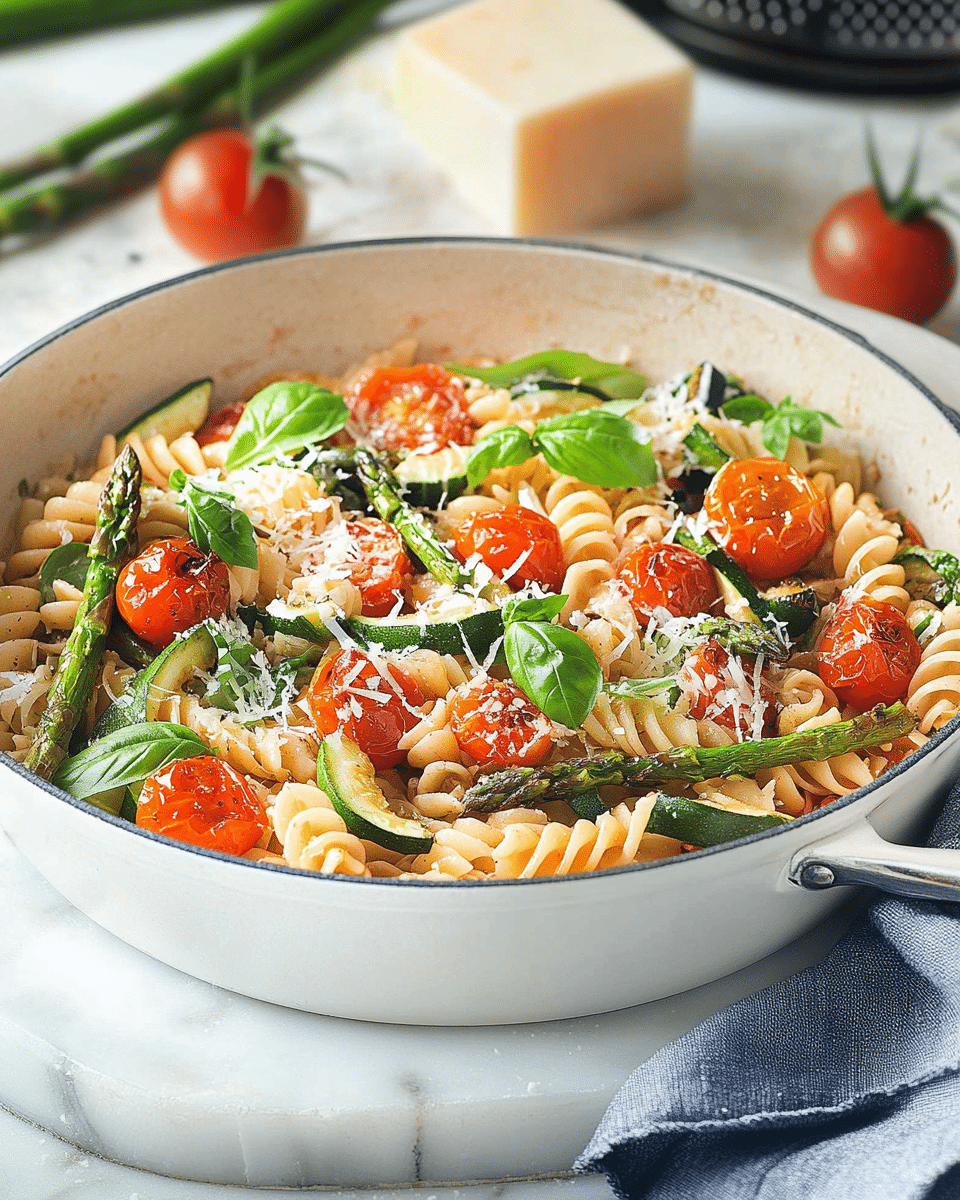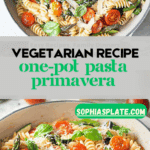This vibrant one-pot Pasta Primavera celebrates fresh seasonal vegetables and simple Italian cooking at its finest. With a light garlic olive oil sauce that lets the vegetables shine, this dish is perfect for a quick weeknight dinner that doesn’t compromise on flavor or nutrition.
Why You’ll Love This Recipe
This bright and colorful pasta dish brings together al dente pasta and crisp-tender vegetables in a light, garlicky sauce. You’ll love that everything comes together in just 30 minutes, making it perfect for busy weeknights. As a versatile vegetarian recipe that can easily be made vegan, it’s a crowd-pleaser that adapts to whatever vegetables you have on hand. The one-pot approach means less cleanup, while the simple olive oil sauce allows the natural flavors of fresh vegetables to take center stage. It’s a restaurant-quality dish that’s both light and satisfying—comfort food you can feel good about eating any day of the week.
Ingredients
(Tip: You’ll find the full list of ingredients and measurements in the recipe card below.)
All-purpose flour forms the base of many pasta varieties, giving this dish its satisfying foundation. If you have dietary restrictions, gluten-free pasta works beautifully as a substitute without compromising the integrity of the dish.
Olive oil creates the backbone of the simple sauce, carrying the garlic flavor throughout the dish while adding a rich mouthfeel. Use a good quality olive oil as its flavor will be prominent.
Garlic infuses the entire dish with its aromatic qualities, bringing depth and character to the light sauce. Fresh is best, but pre-minced garlic can work in a pinch.
Lemon juice and zest brighten the entire dish with a pop of acidity that balances the richness of the olive oil and complements the fresh vegetables perfectly.
Broccoli florets add texture, color, and nutritional value with their slightly crunchy bite and ability to absorb the flavors of the sauce.
Carrots bring natural sweetness and a pop of orange color, contributing to both flavor and visual appeal.
Snap peas offer a sweet crunch that contrasts beautifully with the pasta’s texture; frozen peas make an excellent substitute when snap peas aren’t in season.
Zucchini adds a tender texture and mild flavor that soaks up the garlic and lemon notes beautifully.
Red bell pepper contributes vibrant color and a sweet, slightly fruity note that rounds out the vegetable medley.
Red chili flakes provide an optional touch of heat that can be adjusted to your preference or omitted entirely.
Parsley or basil brings fresh, herbaceous notes that elevate the finished dish with their aromatic qualities.
Parmesan cheese (regular or vegan) adds a savory, umami finish that ties all the flavors together with its salty richness.
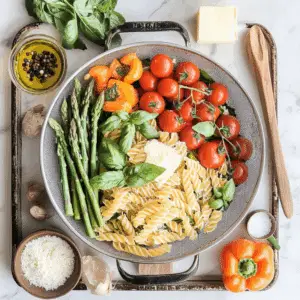
Directions
- Prepare all vegetables by chopping them into uniform pieces to ensure even cooking.
- Bring a large pot of salted water to a boil. Once boiling, blanch the broccoli, carrots, and snap peas (or frozen peas) for 2-3 minutes, then drain and set aside.
- In the same pot of water, cook the pasta according to package instructions until al dente. Before draining, reserve ¼ cup of pasta water, then lightly coat drained pasta with olive oil to prevent sticking.
- In a large skillet, heat olive oil over medium heat. Add minced garlic and sauté for 30 seconds, stirring constantly to prevent burning. Add red chili flakes if desired.
- Add the blanched vegetables and any remaining fresh vegetables (zucchini and bell pepper) to the skillet. Cook for 3-4 minutes until slightly softened but still vibrant.
- Stir in lemon juice and zest, then season with salt and pepper to taste.
- Add the cooked pasta to the skillet and toss everything together until the pasta is well-coated in the garlic oil sauce.
- If needed, add reserved pasta water a tablespoon at a time to achieve desired consistency.
- Serve immediately, garnished with fresh herbs and Parmesan cheese, with an optional drizzle of olive oil.
Servings and Timing
This recipe makes 4 generous servings and comes together in just 30 minutes from start to finish. Each serving contains approximately 400 calories, making it a balanced main course. The quick preparation time makes it perfect for weeknight dinners, while the colorful presentation is impressive enough for casual entertaining.
Variations
Mediterranean Version: Add olives, artichoke hearts, and feta cheese for a Greek-inspired twist.
Summer Harvest: When tomatoes are at their peak, add halved cherry tomatoes, fresh corn kernels, and basil for a celebration of summer produce.
Autumn Pasta Primavera: Incorporate roasted butternut squash, Brussels sprouts, and sage for a fall-inspired variation.
Asian Fusion: Use rice noodles and add ginger, soy sauce, and sesame oil to the sauce for an East-meets-West interpretation.
Protein Additions: For a heartier meal, add grilled chicken, shrimp, or white beans to increase the protein content.
Creamy Primavera: For those who prefer a richer sauce, add a splash of cream or coconut milk (for a vegan option) to the garlic oil base.
Storage/Reheating
This Pasta Primavera will keep well in an airtight container in the refrigerator for 3-4 days. The flavors often develop nicely overnight, making it a excellent candidate for meal prep or planned leftovers.
When reheating, add a splash of water or olive oil to revive the sauce, as pasta tends to absorb liquid when stored. Gently warm over medium-low heat in a covered skillet, stirring occasionally to ensure even heating without overcooking the vegetables.
For individual portions, microwave on medium power for 1-2 minutes, stirring halfway through. A covered microwave-safe container will help retain moisture.
Freezing is not recommended for this dish as the texture of the vegetables and pasta will deteriorate upon thawing.
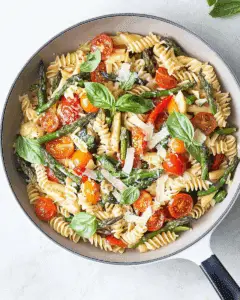
FAQs
Can I make Pasta Primavera ahead of time?
You can prep all the vegetables a day in advance and store them in the refrigerator. For best results, cook the pasta and assemble the dish just before serving to maintain optimal texture and freshness.
How do I make this recipe vegan?
Simply omit the Parmesan cheese or use a vegan Parmesan alternative. The rest of the recipe is naturally vegan as it relies on olive oil rather than butter or cream.
What’s the best pasta shape to use for Pasta Primavera?
Long pasta like spaghetti or linguine works beautifully with the light sauce, but shorter shapes like penne, farfalle, or rotini are excellent for catching small vegetables and bits of garlic in their crevices.
Can I add protein to this vegetarian dish?
Absolutely! Grilled chicken, sautéed shrimp, or white beans make excellent additions. For vegetarian options, consider adding tofu, tempeh, or a sprinkle of toasted pine nuts.
Why is my Pasta Primavera dry?
Reserve some pasta cooking water before draining. This starchy water is perfect for loosening the sauce if it becomes too dry. Add it a tablespoon at a time until you reach your desired consistency.
How can I prevent my vegetables from becoming mushy?
Blanch harder vegetables briefly and remember that they’ll continue cooking slightly when combined with the hot pasta. Aim for crisp-tender vegetables that still have a bit of bite to them.
What can I substitute if I don’t have fresh vegetables?
Frozen vegetable medleys work well in a pinch. Just thaw and drain them before adding to ensure they don’t release too much water into your dish.
How can I make this dish more flavorful without adding more salt?
Increase the garlic, add more fresh herbs, or finish with a squeeze of additional lemon juice. A sprinkle of nutritional yeast adds savory depth for those avoiding cheese.
Is Pasta Primavera authentically Italian?
While it has Italian influences, Pasta Primavera was actually created in New York in the 1970s. It’s an Italian-American creation that celebrates the concept of fresh, seasonal vegetables.
Can I use whole wheat or alternative pasta for a healthier version?
Absolutely! Whole wheat, chickpea, lentil, or other alternative pastas work well in this recipe. Just be aware that cooking times may vary, so follow package instructions for al dente doneness.
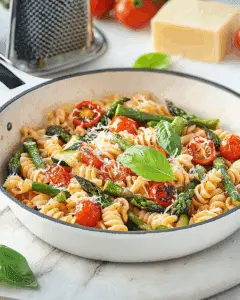
Conclusion
This One-Pot Pasta Primavera embodies the philosophy that simple ingredients, prepared thoughtfully, create the most satisfying meals. The beauty of this dish lies in its versatility—adapt it to whatever vegetables are in season or already in your refrigerator. The light garlic and olive oil sauce allows the natural flavors of the vegetables to shine while keeping the dish fresh and vibrant. Whether you’re cooking for a family weeknight dinner or looking to impress guests with minimal effort, this Pasta Primavera delivers both convenience and flavor. It reminds us that eating well doesn’t have to be complicated—sometimes the most memorable meals are the ones that celebrate ingredients in their purest form.
Print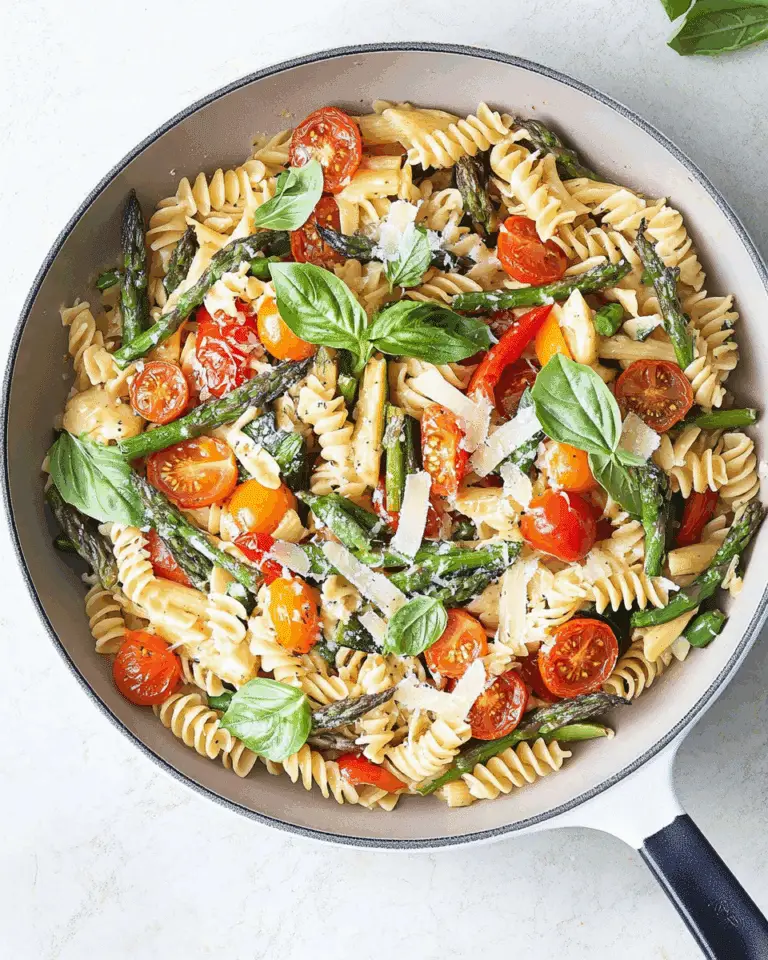
One-Pot Pasta Primavera
Pasta Primavera is a classic Italian dish that celebrates fresh, seasonal vegetables combined with pasta, making it perfect for vegetarians. It can easily be made vegan with a few substitutions.
- Total Time: 30 minutes
- Yield: 4 servings
Ingredients
- 1 cup broccoli florets
- 1 cup julienned carrots
- 1 cup snap peas or frozen peas
- 1 zucchini, sliced into half-moons
- 1 red bell pepper, thinly sliced
- 12 ounces spaghetti, linguine, or penne (use gluten-free pasta if needed)
- 3 tablespoons olive oil
- 4 garlic cloves, minced
- 1/2 teaspoon red chili flakes (optional)
- Juice and zest of 1 lemon
- Salt and pepper to taste
- Fresh parsley or basil, chopped (for garnish)
- Vegan Parmesan or regular Parmesan (for garnish)
- A drizzle of olive oil (optional)
Instructions
- Chop and slice the vegetables into uniform pieces to ensure even cooking. Bring a large pot of salted water to a boil.
- Once the water is boiling, blanch the broccoli, carrots, and snap peas (or frozen peas) for 2–3 minutes. Drain and set aside.
- Cook for 3–4 minutes until they’re slightly softened but still vibrant.
- In the same pot of boiling water, cook the pasta according to the package instructions until al dente. Reserve 1/4 cup of pasta water before draining.
- Drizzle the pasta with a touch of olive oil to prevent sticking while you finish the sauce.
- In a large skillet, heat the olive oil over medium heat. Add the minced garlic and sauté for 30 seconds, stirring constantly to prevent burning. If a touch of heat is preferred, sprinkle in the red chili flakes.
- Add the blanched and sautéed vegetables to the skillet, tossing them in the garlic-infused oil.
- Stir in the lemon juice and zest, which brighten the dish with a hint of acidity. Season with salt and pepper to taste.
- Add the cooked pasta to the skillet with the vegetables and sauce. Toss everything together until the pasta is well-coated in the light, garlicky oil.
- If needed, use the reserved pasta water to adjust the consistency of the sauce, a tablespoon at a time.
Notes
- Use Fresh, Seasonal Vegetables: The beauty of Pasta Primavera lies in its adaptability. Feel free to swap the listed vegetables for whatever is in season — such as asparagus, cherry tomatoes, or mushrooms.
- Cook Vegetables Just Right: Overcooking vegetables can dull their color and texture. Aim for a crisp-tender bite to keep the dish vibrant.
- Choose the Right Pasta: Long pasta like spaghetti or linguine works well for light sauces, but penne or farfalle are great options if you prefer shorter pasta shapes.
- Prep Time: 10 minutes
- Cook Time: 20 minutes
- Category: Main Course
- Method: Stovetop
- Cuisine: Italian
- Diet: Vegetarian
Nutrition
- Serving Size: 1/4 of the recipe
- Calories: 400 kcal
- Sugar: 6g
- Sodium: 150 mg
- Fat: 12g
- Saturated Fat: 2g
- Unsaturated Fat: 9g
- Trans Fat: 0g
- Carbohydrates: 60g
- Fiber: 6g
- Protein: 10g
- Cholesterol: 0mg

